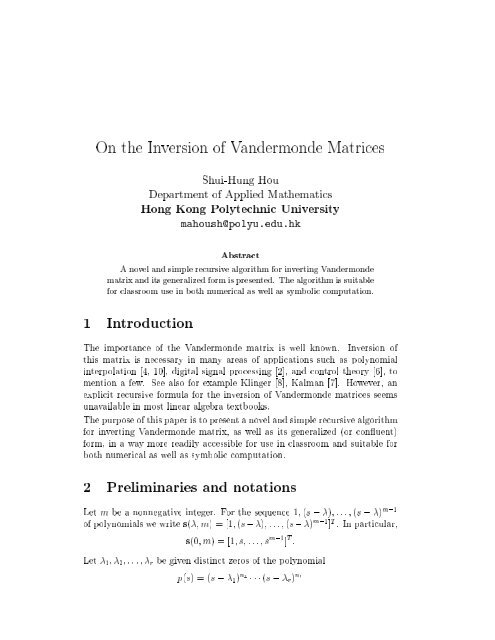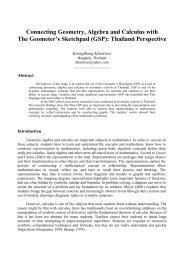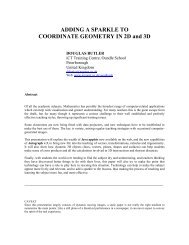1 Introduction 2 Preliminaries and notations - Any2Any ...
1 Introduction 2 Preliminaries and notations - Any2Any ...
1 Introduction 2 Preliminaries and notations - Any2Any ...
Create successful ePaper yourself
Turn your PDF publications into a flip-book with our unique Google optimized e-Paper software.
On the Inversion of V<strong>and</strong>ermonde Matrices<br />
Shui-Hung Hou<br />
Department of Applied Mathematics<br />
Hong Kong Polytechnic University<br />
mahoush@polyu.edu.hk<br />
Abstract<br />
Anovel <strong>and</strong> simple recursive algorithm for inverting V<strong>and</strong>ermonde<br />
matrix <strong>and</strong> its generalized form is presented. The algorithm is suitable<br />
for classroom use in both numerical as well as symbolic computation.<br />
1 <strong>Introduction</strong><br />
The importance of the V<strong>and</strong>ermonde matrix is well known. Inversion of<br />
this matrix is necessary in many areas of applications such as polynomial<br />
interpolation [4, 10], digital signal processing [2], <strong>and</strong> control theory [6], to<br />
mention a few. See also for example Klinger [8], Kalman [7]. However, an<br />
explicit recursive formula for the inversion of V<strong>and</strong>ermonde matrices seems<br />
unavailable in most linear algebra textbooks.<br />
The purpose of this paper is to present anovel <strong>and</strong> simple recursive algorithm<br />
for inverting V<strong>and</strong>ermonde matrix, as well as its generalized (or conuent)<br />
form, in a way more readily accessible for use in classroom <strong>and</strong> suitable for<br />
both numerical as well as symbolic computation.<br />
2 <strong>Preliminaries</strong> <strong>and</strong> <strong>notations</strong><br />
Let m be a nonnegative integer. For the sequence 1; (s , );:::;(s , ) m,1<br />
of polynomials we write s(; m) =[1; (s , );:::;(s , ) m,1 ] T . In particular,<br />
s(0;m)=[1;s;:::;s m,1 ] T :<br />
Let 1 ; 2 ;:::; r be given distinct zeros of the polynomial<br />
p(s) =(s , 1 ) n1 (s , r ) nr
with n 1 + :::+ n r = n. The generalized (or conuent) V<strong>and</strong>ermonde matrix<br />
related to the zeros of p(s) is known to be<br />
V =[V 1 V 2 V r ] ; (1)<br />
where the block matrix V k = V ( k ;n k ) is of order n n k , having elements<br />
i,1<br />
V ( k ;n k ) ij =<br />
j,1 <br />
i,j<br />
k<br />
for i j <strong>and</strong> zero otherwise (k = 1; 2;:::;r; i =<br />
1; 2;:::;n; j = 1; 2;:::;n k ). More specically, V k is the n n k matrix of<br />
coecients that appears in the truncated Taylor expansion at k , modulo<br />
(s , k ) n k,ofs(0;n). That is,<br />
s(0;n)=V ( k ;n k )s( k ;n k ) mod (s , k ) n k<br />
:<br />
In the case the zeros 1 ;:::; r of p(s) are simple, we have the usual V<strong>and</strong>ermonde<br />
matrix, namely,<br />
V =<br />
2<br />
6<br />
4<br />
1 1 1<br />
1 2 r<br />
7<br />
. . . 5 :<br />
n 1,1<br />
1<br />
n 2,1<br />
2<br />
nr,1<br />
r<br />
It will be shown that the inverse of the generalized V<strong>and</strong>ermonde matrix V<br />
in (1) has a form<br />
2 3<br />
W 1<br />
W<br />
V ,1 =<br />
2<br />
6<br />
4<br />
7<br />
. 5 ;<br />
W r<br />
where each block matrix W k is of order n k n, <strong>and</strong> may be computed by<br />
means of a recursive procedure.<br />
Generally, the inverse of the usual V<strong>and</strong>ermonde matrix [3], as well as the<br />
inverse of the generalized V<strong>and</strong>ermonde matrix [9] are based on using interpolation<br />
polynomials.<br />
Our approach is based on using the Leverrier-Faddeev algorithm [1, 5, 10],<br />
which states that the resolvent ofagiven n n matrix A is given by<br />
(sI , A) ,1 = B 1s n,1 + B 2 s n,2 + + B n<br />
s n + a 1 s n,1 + + a n<br />
; (2)<br />
where det(sI , A) =s n + a 1 s n,1 + + a n is the characteristic polynomial<br />
3
of the matrix A, <strong>and</strong>all the B j matrices are of order n n, satisfying<br />
B 1 = I; a 1 = , 1 1 tr(AB 1);<br />
B 2 = AB 1 + a 1 I; a 2 = , 1 2 tr(AB 2);<br />
.<br />
.<br />
B n = AB n,1 + a n,1I; a n = , 1 tr(AB n n)<br />
with 0=AB n + a n I terminating as a check of computation. Here tr st<strong>and</strong>s<br />
for the trace of a matrix.<br />
3 Main result<br />
Let J = diag(J 1 ;:::;J r ) be the block diagonal matrix, where<br />
2<br />
3<br />
k 1 0 0<br />
0 k 1 .<br />
J k = J( k ;n k )=<br />
0<br />
...<br />
... 0<br />
6<br />
4<br />
7<br />
. k 1 5<br />
0 0 0 k<br />
is the n k n k Jordan block with eigenvalue k . Then J has characteristic<br />
polynomial det(sI , J) =(s , 1 ) n1 (s , r ) nr<br />
= p(s).<br />
Substituting A = J in equations (2) <strong>and</strong> (3) of the Leverrier-Faddeev algorithm,<br />
we see immediately that<br />
where<br />
p(s)(sI , J) ,1 = B 1 s n,1 + B 2 s n,2 + + B n ; (4)<br />
B 1 = I;<br />
B 2 = JB 1 + a 1 I;<br />
<br />
B n = JB n,1 + a n,1I;<br />
0 = JB n + a n I:<br />
J = diag(J 1 ;:::;J r ) being block diagonal, so are all the B j matrices. In fact,<br />
B j =diag(B j;1 ;B j;2 ;:::;B j;r );<br />
j =1; 2;:::;n;<br />
<strong>and</strong> each block matrix B j;k is of order n k n k , satisfying<br />
B 1;k = I k ;<br />
B 2;k = J k B 1;k + a 1 I k ;<br />
<br />
B n;k = J k B n,1;k + a n,1I k ;<br />
0 = J k B n;k + a n I k ;<br />
(3)<br />
(5)
where I k is the n k n k identity matrix.<br />
Let us now put<br />
p k (s) =<br />
p(s)<br />
; k =1;:::;r:<br />
(s , k ) n k<br />
Dene also the n k -dimensional column vector k = [0; ; 0; 1] T , <strong>and</strong> write<br />
=[ T 1<br />
; ;r T ] T .<br />
If we postmultiply both sides of equation (4) by the column vector , we<br />
easily get 2<br />
3 2 3<br />
p 1 (s)s( 1 ;n 1 ) H<br />
6<br />
4 .<br />
7<br />
5 = 1<br />
6<br />
4 .<br />
7<br />
5 s(0;n): (6)<br />
p r (s)s( r ;n r ) H r<br />
Each H k is of the form<br />
H k = h B n;k k B 1;k k<br />
i<br />
<strong>and</strong> has order n k n.<br />
Comparing in turn for k =1; 2;:::;r the truncated Taylor expansions at k ,<br />
modulo (s , k ) n k, of both sides in (6) <strong>and</strong> putting these results together, we<br />
get<br />
2 3<br />
H 1<br />
diag(P 1 ;:::;P r )= 6<br />
h i<br />
4 .<br />
7<br />
5 V1 V r ;<br />
H r<br />
where each block P k is a n k n k upper triangular matrix given by<br />
P k = p k (J k )=<br />
n k ,1<br />
X<br />
j=0<br />
p (j)<br />
k<br />
( k )<br />
(N k ) j :<br />
j!<br />
It is noted here that N k = J(0;n k )=J k , k I k is nilpotent of order n k .<br />
If we can show that each P k is invertible, then<br />
2 3<br />
P ,1<br />
1 H 1<br />
V ,1 = 6<br />
4 .<br />
7<br />
5 : (8)<br />
P<br />
r ,1 H r<br />
To this end we require the following lemma which is an easy consequence of<br />
the partial fraction expansion of 1=p(s) <strong>and</strong>the fact that N k is nilpotent.<br />
(7)
Lemma 1 Let there be given the partial fraction expansion<br />
1<br />
rX<br />
p(s) =<br />
k=1<br />
Then for k =1; 2;:::;r<br />
K k;nk<br />
(s , k ) n k<br />
X<br />
n k ,1<br />
P ,1<br />
k<br />
=<br />
j=0<br />
where the polynomial K k (s) is given by<br />
+ K k;n k ,1<br />
(s , k ) + + K !<br />
k;1<br />
:<br />
n k,1<br />
s , k<br />
K k;j (N k ) j = K k (J k );<br />
K k (s) =K k;nk + K k;nk ,1(s , k )++ K k;1 (s , k ) n k,1<br />
:<br />
Putting the above results together with equations (7) <strong>and</strong> (8), we are now<br />
ready to state our main result:<br />
Theorem 1 The inverse of V = [V 1 V 2 :::V r ] related to the distinct zeros<br />
1 ;:::; r of p(s) is given by<br />
2 3<br />
W 1<br />
W<br />
V ,1 =<br />
2<br />
6<br />
4<br />
7<br />
. 5 ;<br />
W r<br />
where each block matrix<br />
W k = W ( k ;n k )= h K k (J k )B n;k k K k (J k )B n,1;k k K k (J k )B 1;k k<br />
i<br />
is of order n k n.<br />
Taking into account of (5), we nd that K k (J k )B j;k = B j;k K k (J k );j =<br />
1; 2;:::;n, so that B 1;k K k (J k )=K k (J k ), <strong>and</strong> for j =2;:::;n<br />
B j;k K k (J k ) = J k B j,1;kK k (J k )+a j,1K k (J k )<br />
= ( k I k + N k )B j,1;kK k (J k )+a j,1K k (J k ):<br />
Moreover, ( k I k + N k )B n;k K k (J k )+a n K k (J k )=0.
4 The Algorithm<br />
Based on the results obtained in the last section, we are now ready to give a<br />
recursive algorithm for inverting generalized V<strong>and</strong>ermonde matrix.<br />
The Algorithm:<br />
Let 1 ; 2 ;:::; r be distinct zeros of the polynomial<br />
p(s) = (s , 1 ) n1 (s , r ) nr<br />
= s n + a 1 s n,1 + + a n<br />
given together with the partial fraction expansion of<br />
1<br />
rX<br />
p(s) = K k;nk<br />
+ K k;n k ,1<br />
(s , k ) n k<br />
(s , k ) + + K !<br />
k;1<br />
:<br />
n k,1<br />
s , k<br />
k=1<br />
For each k 2f1; 2;:::;rg, compute recursively polynomials h 1 ;h 2 ;:::;h n of<br />
degree at most n k , 1by means of the following scheme:<br />
terminating at<br />
h 1 (s) = K k;nk + sK k;nk ,1 + + s n k,1<br />
K k;1 ;<br />
h 2 (s) = ( k + s)h 1 (s)+a 1 h 1 (s) mod s n k<br />
;<br />
h 3 (s) = ( k + s)h 2 (s)+a 2 h 1 (s) mod s n k<br />
;<br />
.<br />
h n (s) = ( k + s)h n,1(s)+a n,1h 1 (s) mod s n k<br />
;<br />
0=( k + s)h n (s)+a n h 1 (s) mod s n k<br />
:<br />
Obtain a block matrix W k = W ( k ;n k ) of order n k n via the equality<br />
h<br />
s<br />
n k ,1<br />
s n k,2<br />
1 i W ( k ;n k )= h h n h n,1 h 1<br />
i<br />
:<br />
The inverse of the generalized V<strong>and</strong>ermonde matrix V related to the distinct<br />
zeros 1 ; 2 ;:::; r of p(s) may then be given by<br />
V ,1 = [V ( 1 ;n 1 )V ( 2 ;n 2 ) V ( r ;n r )] ,1<br />
=<br />
2<br />
6<br />
4<br />
W ( 1 ;n 1 )<br />
W ( 2 ;n 2 )<br />
.<br />
W ( r ;n r )<br />
3<br />
7<br />
5 :
Let us now give some supplementary remarks on the above algorithm.<br />
(i) A check on the accuracy of the computation of polynomials h 1 ;:::;h n is<br />
provided by the last polynomial ( k + s)h n (s)+a n h 1 (s), which should<br />
result identically in the zero polynomial 0 when modulo s n k<br />
is performed.<br />
(ii) The coecients a 1 ;a 2 ;:::;a n of the polynomial p(s) may be recursively<br />
computed using (3) with A = diag( 1 ;:::; 1 ;:::; r ;:::; r ).<br />
| {z }<br />
n 1<br />
| {z }<br />
(iii) The partial fraction coecients K k;nk ;K k;nk ,1;:::;K k;1 used in the construction<br />
of the starting polynomial h 1 (s) may be obtained by exp<strong>and</strong>ing<br />
n<br />
1<br />
p k (s) = k ,1<br />
X<br />
K k;nk ,j(s , k ) j + <br />
j=0<br />
in powers of (s , k ). They may also be recursively computed using<br />
the following scheme:<br />
K k;nk = 1=p k;0 ;<br />
K k;nk ,j =<br />
P j<br />
i=1<br />
p k;i K k;nk ,j+i<br />
,<br />
p k;0<br />
(j =1;:::;n k , 1);<br />
where p k (s) = n,n P k<br />
j=0<br />
p k;j (s , k ) j .<br />
5 Illustrative example<br />
The following example will serve to illustrate the recursive algorithm presented<br />
above. Let the generalized V<strong>and</strong>ermonde matrix V in (1) be given<br />
by<br />
2<br />
3 2<br />
3<br />
1 0 0 1 1 0 0 1<br />
V =<br />
1 1 0 2<br />
6<br />
4 2 1<br />
2 1 1 2 7<br />
2 5 = ,2 1 0 3<br />
6<br />
4 4 ,4 1 9 7<br />
5 ;<br />
3 1<br />
3 2 1<br />
3 1 3 2<br />
,8 12 ,6 27<br />
for which 1 = ,2;n 1 = 3, <strong>and</strong> 2 = 3;n 2 = 1. The coecients of the<br />
polynomial p(s) = (s +2) 3 (s , 3) are given by a 1 = 3;a 2 = ,6;a 3 = ,28,<br />
nr
<strong>and</strong> a 4 = ,24. It is easy to determine the partial fraction expansion of 1=p(s)<br />
to be<br />
1<br />
(s +2) 3 (s , 3) = , 1 5<br />
(s +2) + , 1<br />
25<br />
3 (s +2) + , 1<br />
1<br />
125<br />
2 s +2 + 125<br />
s , 3 :<br />
Let us consider rst the case 1 = ,2. Clearly<br />
Then<br />
h 1 (s) =, 1 5 ,<br />
s<br />
25 , s2<br />
125 :<br />
h 2 (s) = (,2+s)h 1 (s)+3h 1 (s) mod s 3<br />
= , 1 5 , 6s<br />
25 , 6s2<br />
125 ;<br />
h 3 (s) = (,2+s)h 2 (s) , 6h 1 (s) mod s 3<br />
= 8 5 + 13s<br />
25 , 12s2<br />
125 ;<br />
h 4 (s) = (,2+s)h 3 (s) , 28h 1 (s) mod s 3<br />
= 12 5 + 42s<br />
25 + 117s2<br />
125 :<br />
As a check of computation, we verify that<br />
(,2+s)h 4 (s) , 24h 1 (s) mod s 3 = 117s3<br />
125 mod s3 =0:<br />
h i h i<br />
Thus it follows from s 2 s 1 W 1 = h 4 h 3 h 2 h 1 that<br />
2<br />
3<br />
117<br />
, 12 , 6 , 1<br />
125 125 125 125<br />
42 13<br />
W 1 = 6<br />
,<br />
4<br />
6 , 1 7<br />
25 25 25 25 5 :<br />
Similarly, for 2 =3we nd that<br />
h 1 (s) = 1<br />
125 ;<br />
12<br />
5<br />
8<br />
5<br />
, 1 5<br />
, 1 5<br />
h 2 (s) = (3 + s)h 1 (s)+3h 1 (s) mod s = 6<br />
125 ;<br />
h 3 (s) = (3 + s)h 2 (s) , 6h 1 (s) mod s = 12<br />
125 ;<br />
h 4 (s) = (3 + s)h 3 (s) , 28h 1 (s) mod s = 8<br />
125 :
<strong>and</strong><br />
(3 + s)h 4 (s) , 24h 1 (s) mod s =3<br />
Then h 1 i W 2 = h h 4 h 3 h 2 h 1<br />
i<br />
gives<br />
8 24<br />
125 , 125 =0:<br />
W 2 = h 8<br />
125<br />
12<br />
125<br />
6<br />
125<br />
1<br />
125<br />
i<br />
:<br />
Finally, we have<br />
V ,1 =<br />
"<br />
W1<br />
#<br />
=<br />
W 2<br />
2<br />
6<br />
4<br />
117<br />
125<br />
42<br />
25<br />
12<br />
5<br />
8<br />
125<br />
, 12<br />
125<br />
13<br />
25<br />
8<br />
5<br />
12<br />
125<br />
, 6<br />
125<br />
, 6<br />
25<br />
, 1 5<br />
6<br />
125<br />
, 1<br />
125<br />
, 1<br />
25<br />
, 1 5<br />
1<br />
125<br />
3<br />
7<br />
5<br />
:<br />
Acknowledgment<br />
This work was supported by the Research Committee of The Hong Kong<br />
Polytechnic University (Grant No.G-S744).<br />
References<br />
[1] D. K. Faddeev <strong>and</strong> V. N. Faddeeva, Computational Methods of<br />
Linear Algebra, Freeman, San Francisco, 1963.<br />
[2] H. K. Garg, Digital Signal Processing Algorithms, CRC Press, 1998.<br />
[3] F. A. Graybill, Matrices with Applications to Statistics, second ed.,<br />
Wadsworth, Belmont, Calif., 1983.<br />
[4] R. A. Horn <strong>and</strong> C. R. Johnson, Matrix Analysis, Cambridge University<br />
Press, 1985.<br />
[5] S. H. Hou, On Leverrier-Faddeev Algorithm, Proceedings of the<br />
Third Asian Technology Conference in Mathematics, Yang et al (Eds.),<br />
Springer Verlag, 399-403, 1998.<br />
[6] T. Kailath, Linear Systems, Prentice Hall, Inc., Englewood Clis,<br />
New Jersey, 1980.<br />
[7] D. Kalman, The Generalized V<strong>and</strong>ermonde Matrix, Math. Mag., 57:15-<br />
21, 1984.
[8] A. Klinger, The V<strong>and</strong>ermonde Matrix, Amer. Math. Monthly, 74:571-<br />
574, 1967.<br />
[9] N. Macon <strong>and</strong> A. Spitzbart, Inverses of V<strong>and</strong>ermonde Matrices,<br />
Amer. Math. Monthly, 65:95-100, 1958.<br />
[10] C. Pozrikidis, Numerical Computation in Science <strong>and</strong> Engineering,<br />
Oxford University Press, 1998.






